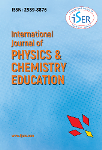A Review of Time Economic Innovative Mnemonics in Chemical Education
Keywords:
Hybridization, Molecular orbital theory, Bond order, Magnetic properties, Spin multiplicity, Aromatic compounds, Alkenes, AlkynesAbstract
In this review article, formulae based mnemonics on chemical education have been highlighted by innovative and time economic way to enhance the interest of students' who belong to paranoia zone of chemistry. Here, I have tried to hub fifteen (15) time economic mnemonics by including thirty-six (36) formulae in the field of chemical education. This article encourages students to solve multiple choice type questions (MCQs) at different competitive examinations in time economic ground.
Downloads
References
Badertscher, M., Bischofberger, K., Munk, Morton E. and Pretsch, E. (2001). A Novel Formalism To Characterize the Degree of Unsaturation of Organic Molecules. J. Chem. Inf. Comput. Sci. 41(4), 889-893. (Retrieved from: https://pubs.acs.org/doi/abs/10.1021/ci000135o)
Cotton, F.A., Wilkinson G. and Gaus, P.L. (2007). Basic Inorganic Chemistry. Wiley: India, 3rd ed., 107, 523, 111.
Das, A., Paul, B., Sanjeev, R. and Jagannadham, V. (2014). Time Economic Innovative Methodology on the Prediction of Hybridization State of Heterocyclic Compounds. IOSR Journal of Applied Chemistry, 7(8 II), 38-39, doi: 10.9790/5736-07412429 (Retrieved from: http://www.iosrjournals.org/iosr-jac/papers/vol7-issue8/Version-2/G07823839.pdf)
Das, A., (2017). Bond-order and Magnetic Behavior of Diatomic Species without Molecular Orbital Theory. World Journal of Chemical Education. 5(4), 128-131, doi: 10.12691/wjce-5-4-2. (Retrieved from: http://www.sciepub.com/WJCE/abstract/7659)
Das, A., Adhikari, S., Paul, B., Sanjeev, R. and Jagannadham, V. (2013). A rapid and innovative method for the identification of aromatic and anti-aromatic nature of organic compounds. World Journal of Chemical Education, 1(1), 6-8, doi: 10.12691/wjce-1-1-2. (Retrieved from: http://www.sciepub.com/WJCE/abstract/632)
Das, A., Pal, D., Adhikari, S., Paul, B., Sanjeev, R. and Jagannadham, V. (2014). Rapid calculation of the number of π-bonds, σ-bonds, single and triple bonds in aliphatic Unsaturated open chain and cycloalkynes. World Journal of Chemical Education, 2(1), 1-3, doi:10.12691/wjce-2-1-1. (Retrieved from: http://www.sciepub.com/WJCE/abstract/1268)
Das, A., Sanjeev, R. and Jagannadham, V. (2014). Innovative And Time Economic Pedagogical Views In Chemical Education - A Review Article. World Journal of Chemical Education, 2(3), 29-38, doi:10.12691/wjce-2-3-1 (Retrieved from: http://pubs.sciepub.com/wjce/2/3/1/index.html)
Douglas, B., Mcdaniel, D. and Alexander, J. (2007). Concepts and Models of Inorganic Chemistry. Wiley: India, 3rd ed., 157, 38.
Engel, T. and Reid, P. (2006). Physical Chemistry.Pearson Benjamin-Cummings, 473, 477–479, ISBN 080533842X. (Retrieved from: https://en.wikipedia.org/wiki/Hund%27s_rule_of_maximum_multiplicity#cite_ref-2)
Finar, I. L. (2004). Organic Chemistry. Vol-1, Pearson, 6th ed., 1, 532, 577-580.
Finar, I. L. (2002). Organic Chemistry. Vol-2, Pearson, 5th ed., 606-637, ISBN: 81-7808-164-4.
Hall, G. G. (1991). The Lennard-Jones Paper of 1929 and the foundations of Molecular Orbital Theory. Advances in Quantum Chemistry. 22, 1-6. doi: 10.1016/S0065-3276(08)60361-5. (Retrieved from: https://www.sciencedirect.com/science/article/pii/S0065327608603615?via%3Dihub)
Hückel, E. (1931).Quantentheoretische Beiträge zum Benzolproblem I. Die Elektronenkonfiguration des Benzols und verwandter Verbindungen. Z. Phys. 70 (3–4), 204–86. Bibcode: 1931ZPhy...70..204H. doi:10.1007/BF01339530. (Retrieved from: https://link.springer.com/article/10.1007%2FBF01339530)
Lee, J. D. (2009). Concise Inorganic Chemistry. Wiley: India and Oxford, 5th ed., 944, 109-112.
Mahan B. M. and Meyers, R. J. (1998). International Student Edition University Chemistry. 4th ed., 599-603.
March, J. (1985). Advanced Organic Chemistry: Reaction, Mechanisms and Structure. Willy: New York, 3rd ed., ISBN 0-471-85472-7.
Morrison, R. T. and Boyd, R.N. (1999). Organic Chemistry. Pearson, 7th ed. 208.
Mulliken, R. S. (1972). Spectroscopy, Molecular Orbitals, and Chemical Bonding. Nobel Lectures, Chemistry 1963-1970. Amsterdam: Elsevier (Retrieved from: https://www.nobelprize.org/nobel_prizes/chemistry/laureates/1966/mulliken-lecture.html)
Pauling, L. (1931). The Nature Chemical Bond. Application of Results Obtained from the Quantum Mechanics and from a Theory of Paramagnetic Susceptibility to the Structure of Molecules. J.Am.Chem.Soc., 53(4), 1367-1400, doi:10.1021/ja01355a027.(Retrieved from: https://pubs.acs.org/doi/abs/10.1021/ja01355a027)
Smith, J. G. (2008). Organic Chemistry. 2nd ed., 616-619.
Solomons T. W. Graham and Fryhle, C. B. (2012). Organic Chemistry. Wiley: India 10th ed., 632-639.
Downloads
Published
How to Cite
Issue
Section
License
Copyright (c) 2018 Authors, IJPCE

This work is licensed under a Creative Commons Attribution-NonCommercial 4.0 International License.
Copyright © Authors


